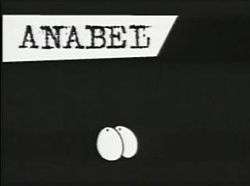Anabel (animated series)
| Anabel | |
|---|---|
 | |
| Genre | Animated series |
| Created by | Lancast Mota |
| Directed by |
Lancast Mota Denise Ehlers |
| Voices of |
Adriana Gimenez Adriane Azevedo Carlos Badia Gabriela Paparelli |
| Opening theme | Sou a Anabel (2nd Season) |
| Ending theme | Instrumental |
| Composer(s) | Carlos Badia |
| Country of origin | Brazil |
| Original language(s) | Portuguese |
| No. of seasons | 2 |
| No. of episodes | 23 |
| Production | |
| Executive producer(s) | Sérgio Martinelli |
| Running time |
7 minutes (Season 1) 10 minutes (Season 2) |
| Production company(s) |
Martinelli Films Estúdio Gato Amarelo |
| Distributor |
Viacom Cultura Marcas |
| Release | |
| Original network |
Nickelodeon (2005) TV Rá-Tim-Bum |
| Original release | 2005 – 2011 |
| External links | |
| Website (closed) | |
Anabel is a Brazilian Flash animated series created by Lancast Mota and produced by Sergio Martinelli. It was the first Brazilian animated series on Nickelodeon Brazil when it debuted on February 26, 2005 in the channel's Nick Patrol program.[1][2] As of 2006 the show moved to the channel TV Rá-Tim-Bum where the second season premiered on February 5, 2011.[3] The show also runs on TV Brasil.
A comic strip adaptation also ran on the children's magazine Recreio.
Premise
Set in the 1930s, the show revolves on a girl named Anabel, who lives with her unnamed parents in the city of Porto Alegre. She goes to school by riding the city's tramcars. On occasion Anabel also travels to fantastical and supernatural adventures from literary novels, encountering monsters and creatures. She also solves mysteries and stops dangers in the city.
The second season introduces the character Ulisses, who travels with Anabel in some of its episodes.
Characters
- Anabel – The 7-year-old protagonist of the show. She enjoys listening to radio dramas and reading fiction books from many authors including Edgar Allan Poe.[4] She's named after the titular figure in Poe's poem "Annabel Lee."[5]
- Anabel's parents – The protagonist's unnamed parents. The father is a pharmacist (cook in Season 2) and the mother is a history teacher.
- Ulisses – Anabel's best friend, who is overweight. His work and help to his friend sometimes fail.
- Theo - A magical crow, friend of Anabel and Ulysses. He is able to create gates to other worlds.
- Inspetor Carangueijo (Inspector Crab) – A detective based in Porto Alegre. He and Anabel cooperate each other to track down a toy thief in the episode "O Homem Fornalha."
Production
Lancast Mota devised and developed the concept of Anabel in the 1990s. He picked the 1930s as the time setting of the series due to its distinctive popular culture field placed apart from electronic-driven media of the present day, which includes television and videogames. Mota and his team wanted the show to take advantage of creative presentations not widely utilized in other animated works, including but not limited to strong literary themes and a lack of violence. Mota also avoided cliches seen in such other animated works, such as adding "a villain who wants to take over the world."[2] The team made the protagonist motivated by non-visual media such as books and radio, which was prevalent in the 1930s.[5]
The show was financed by the Rouanet Law and TV Cultura in 2000.[2]
References
- ↑ "Anabel será o primeiro desenho animado brasileiro". terra.com.br (in Portuguese). Terra Networks. 2005-01-17. Retrieved 2014-08-14.
- 1 2 3 "Estréia Anabel, primeira animação brasileira do canal Nickelodeon". Midiativa (in Portuguese). 2005-02-25. Archived from the original on 2008-06-18. Retrieved 2014-08-14.
- ↑ "Animação "Anabel" ganha episódios inéditos na TV Rá Tim Bum". Universo Online (in Portuguese). Folha da Manhã. 2011-02-03. Retrieved 2014-08-19.
- ↑ Castro, Natalia (2011-01-30). "TV Rá Tim Bum estreia segunda temporada da animação 'Anabel'" [TV Rá Tim Bum premieres second season of 'Anabel'.]. O Globo (in Portuguese). GDA. Retrieved 2014-08-13.
Apesar da pouca idade, adora ouvir radionovelas e a literatura está entre suas atividades favoritas. Principalmente, os livros do escritor americano Edgar Allan Poe.
- 1 2 Canônico, Marco (2005-02-26). "A brasileira "Anabel" remete a Poe e aos anos 30". Universo Online (in Portuguese). Folha da Manhã. Retrieved 2014-08-14. (subscription required (help)).
External links
- Anabel at the Internet Movie Database
- TV Rá-Tim-Bum description
- Character page
- Martinelli webpage
- TV Brasil page